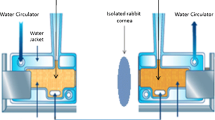Abstract
Due to anatomic barriers and lacrimal drainage it is difficult to obtain therapeutic drug concentrations in the posterior part of the eye after topical drug administrations. Lipophilic cyclodextrins, such as randomly methylated β-cyclodextrin (RMβCD), are known to act both as solubilizers of water-insoluble drugs in aqueous solutions and as penetration enhancers that reduce the barrier function of lipophilic membranes. The purpose of this study was to investigate the effects of RMβCD on dexamethasone delivery from aqueous eye drop solution into rabbit eyes. Dexamethasone (0.5 and 1.5% w/v) drops (50 μl) were administered to the left eye of rabbits (n = 6) and the drug levels measured in different eye tissues 2 h after administration. In aqueous humor dexamethasone levels were 1,190 ± 110 and 1,670 ± 630 ng/g (mean ± SD) after administration of the 0.5 and 1.5% dexamethasone eye drops, respectively. In the retina the levels were 33 ± 7 and 66 ± 49 ng/g, and in optic nerve 41 ± 12 and 130 ± 50 ng/g, respectively. In a previous study the dexamethasone concentration in aqueous humor after topical administration of 1.3% (w/v) dexamethasone eye drops in aqueous 2-hydroxypropyl-β-cyclodextrin (HPβCD) solution was determined to be 320 ± 230 ng/g and 66 ± 20 ng/g after administration of Maxidex® eye drops. Both the hydrophilic HPβCD and the lipophilic RMβCD enhance topical dexamethasone delivery into the eye, but of the two, the lipophilic RMβCD results in higher dexamethasone concentrations.
Similar content being viewed by others
References
Ahmed, I., Gokhale, R.D., Shah, M.V., Patton, T.F.: Physicochemical determinants of drug diffusion across the conjunctiva, sclera, and cornea. J. Pharm. Sci. 76, 583–586 (1987)
Wang, W., Sasaki, H., Chien, D.-S., Lee, V.H.L.: Lipophilicity influence on conjunctival drug penetration in the pigmented rabbit: a comparison with corneal penetration. Curr. Eye Res. 10, 571–579 (1991)
Loftsson, T., Stefánsson, E.: Effect of cyclodextrins on topical drug delivery to the eye. Drug Devel. Ind. Pharm. 23, 473–481 (1997)
Loftsson, T., Stefánsson, E.: Cyclodextrins in eye drop formulations: enhanced topical delivery of corticosteroids to the eye. Acta Ophthalmol. Scand. 80, 144–150 (2002)
Chrai, S.S., Patton, T.F., Mehta, A., Robinson, J.R.: Lacrimal and instilled fluid dynamics in rabbit eye. J. Pharm. Sci. 62, 1112–1121 (1973)
Gangrade, N.K., Gaddipati, N.B., Ganesan, M.G., Reddy, I.K.: Topical ophthalmic formulations: basic considerations. In: Reddy, I.K. (ed.) Ocular Therapeutics and Drug Delivery, pp. 377–403. Technomic Publications, Lancaster (1996)
Loftsson, T., Järvinen, T.: Cyclodextrins in ophthalmic drug delivery. Adv. Drug Deliv. Rev. 36, 59–79 (1999)
Washington, N., Washington, C., Wilson, C.G.: Ocular drug delivery. Physiological pharmaceutics: barriers to drug absorption, pp. 249–270. Taylor and Francis, London (2001)
Myles, M.E., Neumann, D.M., Hill, J.M.: Recent progress in ocular drug delivery for posterior segment disease: emphasis on transsclera iontophoresis. Adv. Drug Deliv. Rev. 57, 2063–2079 (2005)
Raghava, S., Hammond, M., Kompella, U.B.: Periocular routes for retinal drug delivery. Exp. Opin. Drug Deliv. 1, 99–114 (2004)
Yasukawa, T., Ogura, Y., Sakurai, E., Tabata, Y., Kimura, H.: Intraocular sustained drug delivery using implantable polymer devices. Adv. Drug Deliv. Rev. 57, 2033–2047 (2005)
Jonas, J.B.: Intravitreal triamcinolone acetonide for treatment of intraocular oedematous and neovascular diseases. Acta Ophthalmol. Scand. 83, 645–663 (2005)
Lipinski, C.A., Lombardo, F., Dominy, B.W., Feeney, P.J.: Experimental and computatorial approaches to estimate solubility and permeability in drug discovery and development settings. Adv. Drug Deliv. Rev. 46, 3–26 (2001)
Amidon, G.L., Lennernäs, H., Shah, V.P., Crison, J.R.: A theoretical basis for a biopharmaceutic drug classification: the correlation of in vitro drug product dissolution and in vivo bioavailability. Pharm. Res. 12, 413–420 (1995)
Loftsson, T., Masson, M.: Cyclodextrins in topical drug formulations: theory and practice. Int. J. Pharm. 225, 15–30 (2001)
Sinha, V.R., Bindra, S., Kumria, R., Nanda, A.: Cyclodextrin as skin-penetration enhancers. Pharm. Technol. 27(3), 120–138 (2003)
Loftsson, T., Konráǒsdóttir, F., Másson, M.: Influence of aqueous diffusion layer on passive drug diffusion from aqueous cyclodextrin solutions through biological membranes. Pharmazie 61, 83–89 (2006)
Loftsson, T., Sigfússon, S.D., Sigurðsson, H.H., Másson, M.: The effects of cyclodextrins on topical delivery of hydrocortisone: the aqueous diffusion layer. S.T.P. Pharma Sci. 13, 125–131 (2003)
Merkus, F.W.H.M., Verhoef, J.C., Marttin, E., Romeijn, S.G., van der Kuy, P.H.M., Hermens, W.A.J.J., Schipper, N.G.M.: Cyclodextrin in nasal drug delivery. Adv. Drug Deliv. Rev. 36, 41–57 (1999)
Yang, T., Hussain, A., Paulson, J., Abbruscato, T.J., Ahsan, F.: Cyclodextrins in nasal delivery of low-molecular-weight heparins: in vivo and in vitro studies. Pharm. Res. 21, 1127–1136 (2004)
Loftsson, T., Fridriksdottir, H., Thorisdottir, S., Stefansson, E.: The effect of hydroxypropyl methylcellulose on release of dexamethasone from aqueous 2-hydroxypropyl-β-cyclodextrin formulations. Int. J. Pharm. 104:181–184 (1994)
Loftsson, T., Hreinsdóttir, D., Másson, M.: Evaluation of cyclodextrin solubilization of drugs. Int. J. Pharm. 302, 18–28 (2005)
Higuchi, T., Connors, K.A.: Phase-solubility techniques. Adv. Anal. Chem. Instrum. 4, 117–212 (1965)
Weijtens, O., Feron, E.J., Schoemaker, R.C., Cohen, A.F., Lentjes, E.G.W.M., Romijn, F.P.H.T.M., van Meurs, J.C.: High concentration of dexamethasone in aqueous and vitreous after subconjunctival injection. Am. J. Ophthalmol. 128, 192–197 (1999)
Shiah, J.-G., Bhagat, R., Nivaggioli, T., Peng, L., Chou, D., Weber, D.A.: Ocular implant made by a double extrusion process. US Patent Application No.: 2005/0048099, Allergan Inc. 3 March 2005, USA
Acknowledgement
This work was supported by a grant from the Icelandic Centre for Research.
Author information
Authors and Affiliations
Corresponding author
Rights and permissions
About this article
Cite this article
Loftsson, T., Sigurdsson, H.H., Hreinsdóttir, D. et al. Dexamethasone delivery to posterior segment of the eye. J Incl Phenom Macrocycl Chem 57, 585–589 (2007). https://doi.org/10.1007/s10847-006-9253-4
Received:
Accepted:
Published:
Issue Date:
DOI: https://doi.org/10.1007/s10847-006-9253-4




